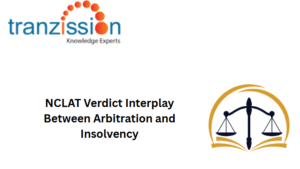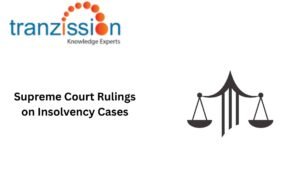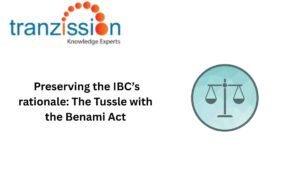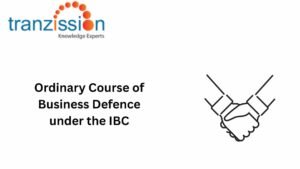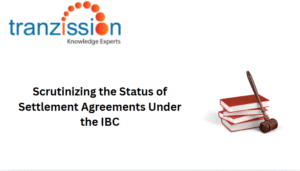
Conflict of Jurisdiction between NCLT and Civil Courts
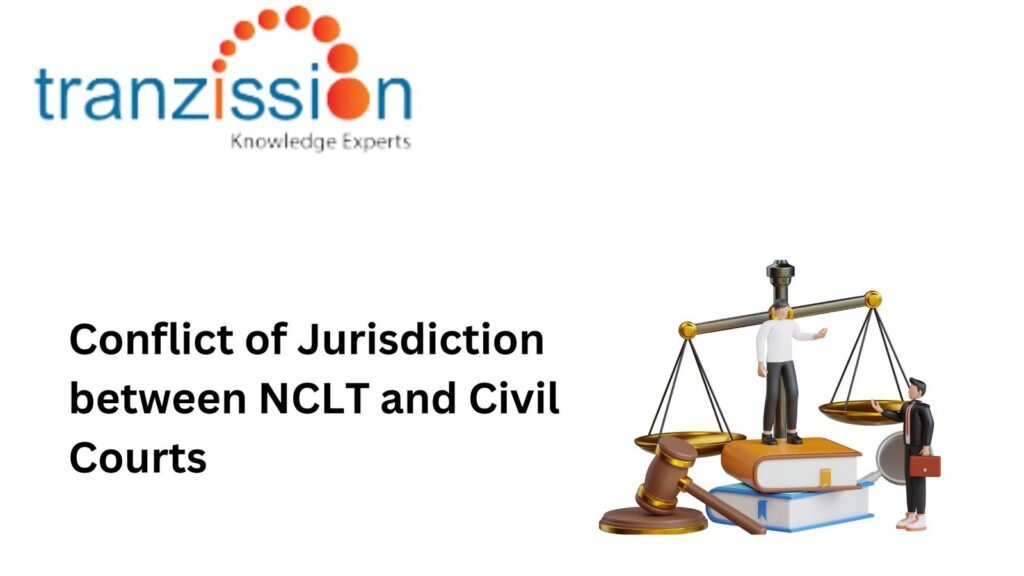
Table of Contents
Conflict of Jurisdiction between NCLT and Civil Courts arises under the Insolvency and Bankruptcy Code, 2016 (IBC), which provides a legal framework for resolving financial distress within a strict timeframe. While the National Company Law Tribunal (NCLT) is designated to handle insolvency matters, other company-related issues fall under the jurisdiction of civil courts. However, the overlapping nature of issues, such as contractual disputes, often blurs the lines between these jurisdictions. Consequently, determining whether the civil court or NCLT has authority in specific company matters remains complex and lacks a straightforward answer.
Legislative Framework
Conflict of Jurisdiction between NCLT and Civil Courtsunder the Adjudicating Authority which handles IBC matters is the National Company Law Tribunal (NCLT). Any person who is aggrieved by the order of the NCLT can file an appeal before the National Company Law Appellate Tribunal (NCLAT). As per section 60(1) of the IBC, the NCLT has territorial jurisdiction over the place where the registered office of the corporate person is located. Section 60(5) of the IBC lists certain matters in which the NCLT has residuary jurisdiction. Section 238 of the IBC is a non-obstante clause that states that the IBC has precedence over legislations facing matters that have similar subject matter, such as the Companies Act, 2013.
The Companies Act, 2013
Conflict of Jurisdiction between NCLT and Civil Courts under the Section 408 of the Companies Act, 2013 (“the Act”) is the parent section that confers the powers upon the NCLT. To provide relief in cases of oppression, sections 241 and 242 confer jurisdiction to the NCLT. Section 430 of the Act states that the civil court shall have no jurisdiction to entertain any suit or proceeding before the NCLT or NCLAT. Reading section 63 of IBC and section 430 of the Act it is clear the NCLT or the NCLAT has the sole jurisdiction to determine the issues of the IBC.
Residuary Jurisdiction of the NCLT
Conflict of Jurisdiction between NCLT and Civil Courts under section 60(5) of IBC, the NCLT has jurisdiction to entertain or dispose of any application or proceedings by or against the corporate debtor or corporate person, any claim made by or against the corporate debtor or corporate person which includes claims by or against any of its subsidiaries in India, and any question of priorities or any question of law or facts, arising out of or in relation to the insolvency resolution or liquidation proceedings of the corporate debtor or corporate person under the IBC.
The Supreme Court set aside the order of the NCLAT in Tata Consultancy Services v. SK Wheels (P) Ltd and observed that the residuary jurisdiction of the NCLT under section 60(5)(c) of the IBC cannot be invoked to adjudicate a contractual dispute between the parties.
Legislative Intent
Conflict of Jurisdiction between NCLT and Civil Courts under the Report of the Bankruptcy Law Reforms Committee (BLRC) referred to NCLT as the forum with jurisdiction over the bankruptcy or liquidation of the companies which includes the original jurisdiction over insolvency matters are streamlined and efficient. In this Report, it was recommended that:
- NCLT should have jurisdiction over adjudication arising out of insolvency and liquidation.
- Debt Recovery Tribunal should be vested with the jurisdiction over individual insolvency and bankruptcy matters.
- NCLAT should have appellate jurisdiction over orders passed by the insolvency regulator.
Indian Jurisprudence on NCLT’s Jurisdiction
Conflict of Jurisdiction between NCLT and Civil Courts under the Supreme Court in Gujarat Urja Vikas Nigam Limited v. Mr. Amit Gupta (Gujrat Urja Case) dismissed the appeal in this case and held that since the termination of the contract was on the ground of insolvency, the dispute “arises out of and relates to the insolvency of the corporate debtor” and the nexus with the insolvency of the corporate debtor must exist. Therefore, it has been established for adjudication of disputes that arise dehors the insolvency of the corporate debtor, the relevant competent authority must be approached. Tata Consultancy Services v. SK Wheels (P) Ltd clarifies the decision in the Gujrat Urja Case and held that the NCLT can use its residuary jurisdiction under the IBC to adjudicate contractual disputes related to insolvency if the disputed contract is central to the resolution process. As per this ruling, it can be stated that the jurisdiction of the NCLT under section 60(5)(c) of IBC cannot be invoked in matters where a termination may take place on grounds unrelated to the insolvency of the corporate debtor. The Supreme Court in Shashi Prakash Khemka v. NEPC Micon held that the civil suit remedy would be completely barred and the power would be vested with the NCLT under section 59 of the Companies Act, 2013. Hence, the NCLT has jurisdiction to handle cases relating to rectification to determine the legality of the rectification.
Key Legal Principles
Conflict of Jurisdiction between NCLT and Civil Courts analysing the provisions of IBC and the Companies Act, judicial precedents, and BLRC, the NCLT has jurisdiction over disputes directly related to insolvency proceedings. This includes the admission or the rejection of insolvency petitions and the supervision of the corporate insolvency resolution process. The NCLAT has jurisdiction over appeals by any stakeholder. Civil courts have jurisdiction over matters that are not related to insolvency, such as mismanagement and oppression as per the provisions under the Companies Act.
Comparative Analysis with Foreign Jurisdictions
Conflict of Jurisdiction between NCLT and Civil Courts under Insolvency and bankruptcy laws of foreign countries offer more streamlined procedures. It is essential to understand how foreign countries establish jurisdiction for handling insolvency matters. It is essential to understand this to develop the current legal system for its drawbacks to increase the efficiency of the NCLT.
U.S. Bankruptcy Law: A Complex Jurisdictional Landscape
Conflict of Jurisdiction between NCLT and Civil Courts under Bankruptcy courts in the U.S. are set up as a division of federal district courts and adjudicate on matters involving Title 11 of the U.S. Bankruptcy Code. Hence, federal courts have exclusive jurisdiction over bankruptcy cases.
Core vs. Non-Core Proceedings
Conflict of Jurisdiction between NCLT and Civil Courts under the jurisdiction of the Bankruptcy Court depends on whether the particular proceeding or case is a core proceeding under Title 28, section 157(b)(2) or a non-core proceeding. The Bankruptcy Court can make a final judgment on the merits of the case if the case is a core proceeding. If the Bankruptcy Court decides that the matter is not a core proceeding, but is related to a bankruptcy case, the judge is allowed to make a final judgment only if the parties give consent to do so.
The Pacor Test
The Pacor Test specifically relates to the jurisdiction of an insolvency matter. This test came into existence with the judgment Pacor, Inc. v. Higgins. The Third Circuit reasoned that a bankruptcy court had “related to” jurisdiction over a matter if the “outcome of the proceedings could conceivably have any effect on the state being administered in bankruptcy.” An action is related to bankruptcy if the outcome could change the debtor’s rights, liabilities, options, or freedom of action, and how it impacts the handling and administration of the bankrupt estate.
Adversary Proceedings
Adversary proceedings under Rule 7001 of the Federal Rules of Bankruptcy Procedure are initiated by the debtor, creditor, or trustee when the cause of action is related to bankruptcy but needs to be handled separately. This process is initiated to enforce some rights vested in them that could not be enforced by filing a motion under the main case. The court in Bushman Custom Farming, LLC v, Stillmunkes (In re Stillmunkes), found that the outcome of the adversary proceeding could “change the value of the creditor’s allowed claim, even though the debtor has not objected to it and it is small relative to the debtor’s overall liabilities.”
Constitutional Challenges
The Supreme Court has observed that where a claim falls under “core proceeding”, the bankruptcy courts may not have jurisdiction if they do not have the constitutional authority to hear such claims. The Supreme Court in Stern v. Marshall, the Supreme Court used the Pacor Test to determine whether a claim or issue is determinable by bankruptcy courts is dependent upon if the legal action is a direct result of the bankruptcy or if it has to be dealt with as a part of the process of approving the creditor’s claims.
The UK Insolvency Framework: A Specialized Approach
Similar to IBC, the UK Insolvency Framework is designed to ensure that the insolvency regime is fair and transparent and helps companies and individuals that are facing financial distress. This Framework includes specialised courts such as the Insolvency Service and the Enterprises Act, 2002.
Jurisdictional Considerations
Section 117(1) of the UK Insolvency Act states that the High Court of England and Wales has jurisdiction over any matters of winding up of companies registered in England and Wales. Under section 120(1) of this Act, the Court of Session of Scotland has jurisdiction to wind up any company registered in Scotland. As per sections 117 and 120, the High Court has jurisdiction over the winding up of companies where it is registered. In addition to this Insolvency and Companies List of the Business and Property Court division takes up matters on insolvency or liquidation and is authorised to handle insolvency matters that appear before the High Court. This includes petitions, applications, and claims that are related to insolvency corporations and individuals.
Specialist Judges and Expertise
When a particular dispute could be brought before a specialised court, the claimant needs to consider whether there are aspects that require the expertise of a specialist judge and choose the list, sub-list, or court in which the relevant specialist judges sit. The claimant in such a decision would have to consider the nature of the dispute and the issue proceedings in an appropriate court if part of the dispute would normally be better suited to being heard in another court or list.
Insights from UNCITRAL
The UNCITRAL Legislative Guide on Insolvency Law gives recommendations on the jurisdiction of the insolvency proceedings. This Guide states to increase the transparency and ease of use of the insolvency law it is important for the law to be clear on the jurisdiction for which it functions. The provisions that do specify which courts have jurisdiction over the insolvency proceedings may not be included in the insolvency law, a reference to the provisions of the law other than the insolvency law that specifies court jurisdiction might usefully be included in the insolvency law. It has been recommended that:
- The insolvency law should specify which debtors have sufficient connection to the State to be subject to its insolvency law. Different approaches may be taken to identifying appropriate connecting factors, but the grounds upon which a debtor can be subject to the insolvency law should include that the debtor has its center of main interests in the State or that the debtor has an establishment in the State
- The insolvency law should establish a presumption that, in the absence of proof to the contrary, a legal person’s center of main interests is in the State in which it has its registered office, and a natural person’s center of main interests is in the State in which that person has their habitual residence.
- The insolvency law should define “establishment” to mean “any place of operations where the debtor carries out a non-transitory economic activity with human means and goods or services”.
- The insolvency law should indicate (or include a reference to the relevant law that establishes) the court that has jurisdiction over the commencement and conduct of insolvency proceedings, including matters arising in the course of those proceedings. Read related article What are the common job roles in the insolvency field?
Lessons for India
After going through the US and UK insolvency laws, India can adopt certain legal actions to develop the current system. The IBC has similarities with the U.S. Bankruptcy Code such as the test of core proceedings or non-core proceedings and the Pacor Test. Section 65(5)(c) of the IBC states that the NCLT decides on matters arising out of or in relation to insolvency resolution or liquidation proceedings which is similar to the concept of core and non-core proceedings. The insolvency laws in India and the UK are different. For instance, the ability to transfer disputes to where the matter may be more conveniently tried is a concept that India could benefit from.
Conflict of Jurisdiction between NCLT and Civil Courts Conclusion
The provisions of the IBC and Companies Act with judicial precedents lay down the grounds of whether the NCLT or civil court has jurisdiction over insolvency and bankruptcy matters. To make the resolution process streamlined and efficient while being fair and transparent, Indian lawmakers can rely on foreign law and the principles they implement for jurisdiction. Navigating the details of insolvency and bankruptcy laws and understanding which jurisdiction the issue should fall in, may be difficult. It is important to stay informed on any updates in the insolvency law to ensure that if you are facing any financial issues or are on your way to becoming an insolvency professional. To access content tailored for your guidance on the insolvency proceeding visit https://tranzission.com/,

